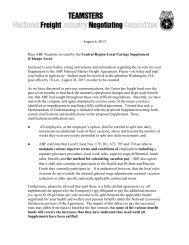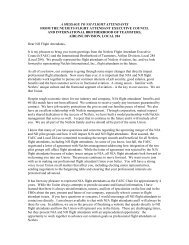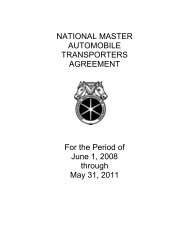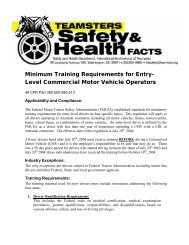The Hazards of Behavior Based Safety - International Brotherhood ...
The Hazards of Behavior Based Safety - International Brotherhood ...
The Hazards of Behavior Based Safety - International Brotherhood ...
Create successful ePaper yourself
Turn your PDF publications into a flip-book with our unique Google optimized e-Paper software.
THE HAZARDS OF BEHAVIOR-BASED SAFETY<br />
<strong>Behavior</strong>-based safety: today and yesterday<br />
“<strong>Behavior</strong>-based safety” is a term used for programs focused on changing the behavior <strong>of</strong><br />
workers in order to prevent occupational injuries and illnesses. <strong>The</strong>se programs rely on the false<br />
claim that workplace injuries and illnesses are the result <strong>of</strong> “unsafe acts.” <strong>Behavior</strong>-based<br />
programs target specific worker behaviors and solicit workers and management in monitoring<br />
these behaviors on the shop floor. Depending on the program, such “observations” may be<br />
followed up with positive reinforcement (complimentary evaluations, prizes, rewards) or<br />
discipline (not necessarily overt).<br />
“<strong>Behavior</strong>-based safety” is not a new concept. It originated in the 1930's and 1940's with the<br />
work <strong>of</strong> H. W. Heinrich at the Travelers Insurance Company. Heinrich conducted “research” on<br />
thousands <strong>of</strong> insurance and injury/illness reports written by corporate supervisors. <strong>The</strong> reports<br />
blamed the workers, so-called “man failure” in the jargon <strong>of</strong> the time, for 73% <strong>of</strong> the accidents.<br />
Heinrich revised this figure upwards to conclude that 88% <strong>of</strong> industrial accidents could be<br />
blamed on workers. Some management-side safety pr<strong>of</strong>essionals have based their work on<br />
Heinrich's faulty theories ever since.<br />
What is wrong with behavior-based safety programs<br />
<strong>Behavior</strong>-based safety programs appeal to many companies because they make health and safety<br />
seem simple, do not require management change, focus on workers and seem cheaper than<br />
correcting health and safety hazards. By requiring workers to monitor each other, behavior based<br />
safety programs generate fear and conflict among members and undermine union solidarity.<br />
By directing attention to the workers who in most cases had little or nothing to do with the<br />
selection <strong>of</strong> machinery, processes, and procedures and methods, such programs undermine<br />
legitimate health and safety activities and excuse management's shortcomings.<br />
Companies selling behavior-based safety programs claim the number <strong>of</strong> lost workdays drops<br />
with these programs. Lost-time accidents are known to be the least reliable measures in
determining the effectiveness <strong>of</strong> a health and safety program since lost workdays rates can<br />
depend on a company's ability to put injured workers on light duty or to discourage workers from<br />
reporting injuries. This can drive safety and health problems underground. In some cases,<br />
companies threaten workers with drug tests, loss <strong>of</strong> over-time opportunities and/or days <strong>of</strong>f if<br />
they report job-related injuries and illnesses. By knowing that if an injury or illness occurs they<br />
will be blamed, workers can be strongly discouraged from reporting injuries and illnesses.<br />
By discouraging workers from reporting injuries, companies know that they stand to be looked<br />
upon favorably by OSHA (the Occupational <strong>Safety</strong> and Health Administration) and to have<br />
lower workers’ compensation rates.<br />
Many companies are also turning to behavior based safety as a way <strong>of</strong> side-stepping the safety<br />
and health risks associated with increased line speeds, work duties, mandatory overtime and<br />
other forms <strong>of</strong> work restructuring. (See IBT Fact Sheet, Overtime and Extended Work Shifts:<br />
Injuries, Illnesses, and Other Effects)<br />
What are the Most Effective Ways to Control <strong>Safety</strong> and Health hazards<br />
To prevent accidents, the emphasis should be on eliminating and minimizing hazardous conditions,<br />
involving equipment, work practices, and chemical, physical or biological agents which might<br />
endanger health and safety at the worksite. Health and safety pr<strong>of</strong>essionals and organizations,<br />
including the IBT <strong>Safety</strong> and Health Department, support a systematic approach to solving safety<br />
and health problems which relies on a “Hierarchy <strong>of</strong> Controls”. This approach emphasizes the<br />
following:<br />
1. Elimination <strong>of</strong> <strong>Hazards</strong><br />
2. Substitution <strong>of</strong> Hazardous Processes or Materials With Less Hazardous<br />
Processes <strong>of</strong> Materials<br />
3. Engineering Controls<br />
4. Training and Administrative Procedures, and<br />
5. Personal Protective Equipment<br />
<strong>Behavior</strong>-based safety programs turn the hierarchy upside down. Most programs begin with the<br />
identification <strong>of</strong> ‘critical worker behaviors.’ Critical worker behaviors typically include wearing<br />
personal protective equipment and following safety procedures. <strong>Behavior</strong>-based safety programs<br />
do not improve safety; in fact they increase the likelihood <strong>of</strong> workers being exposed to serious<br />
health and safety hazards by focusing on the least reliable methods for protecting workers. Worst<br />
<strong>of</strong> all, they are based on an assumption the workplace doesn't need to be redesigned to remove<br />
safety or health hazards and that workers don’t care about their own safety and need to be bribed<br />
or bullied to work safely.<br />
What can be done about it<br />
Like other management proposals and policies that influence conditions <strong>of</strong> work, behavior-based<br />
safety is a bargaining issue. <strong>The</strong> National Labor Relations Board (NLRB) has ruled that<br />
employee safety and health is a mandatory bargaining subject. <strong>The</strong>refore, it is the IBT’s<br />
recommendation that an employer’s proposal to introduce behavior-based safety policies should<br />
be open for negotiation and discussion. Education <strong>of</strong> members is key in terms <strong>of</strong> mobilizing<br />
<strong>International</strong> <strong>Brotherhood</strong> <strong>of</strong> Teamsters<br />
<strong>Safety</strong> and Health Department, Page 2 <strong>of</strong> 3
around this issue. Teamster members, stewards and representatives have worked hard to<br />
establish strong safety and health initiatives in all <strong>of</strong> Teamster industries. Since behavior-based<br />
safety fails to address the root causes <strong>of</strong> injuries and illnesses, it is important for union members<br />
and representatives to demand resources for safety programs targeting workplace hazards.<br />
<strong>The</strong> IBT <strong>Safety</strong> and Health Department can assist in evaluating various policies that might have<br />
an adverse effect on the safety and health <strong>of</strong> our members.<br />
For more information, please contact the <strong>Safety</strong> and Health Department at<br />
(202) 624-6960.<br />
With special thanks<br />
to the United Food and Commercial Workers Union (UFCW) and the Transport Workers Union <strong>of</strong><br />
America (TWU).<br />
<strong>International</strong> <strong>Brotherhood</strong> <strong>of</strong> Teamsters<br />
<strong>Safety</strong> and Health Department, Page 3 <strong>of</strong> 3
















